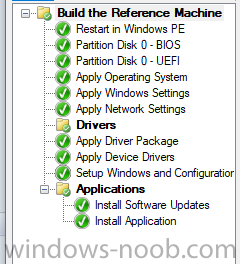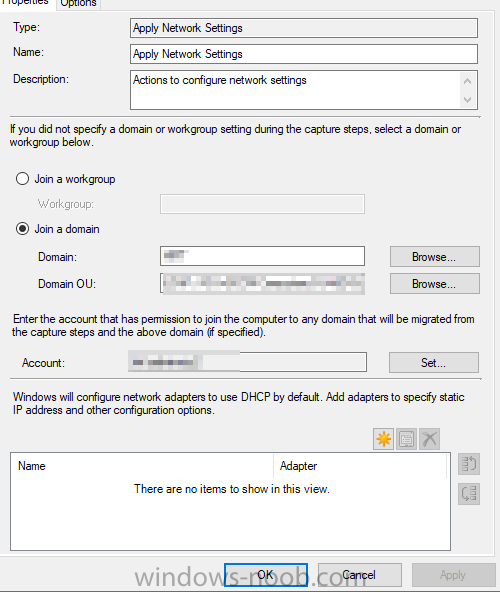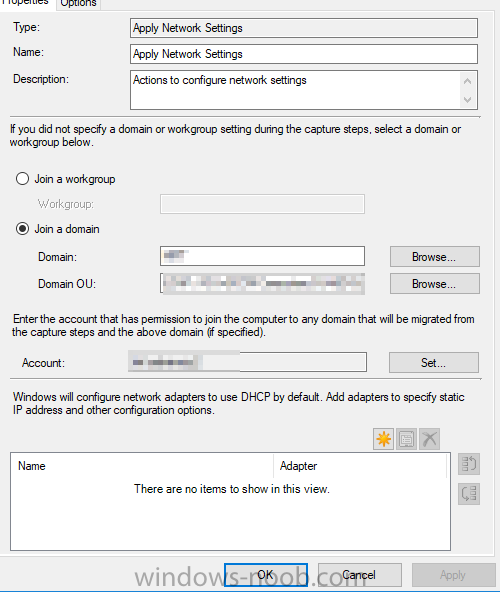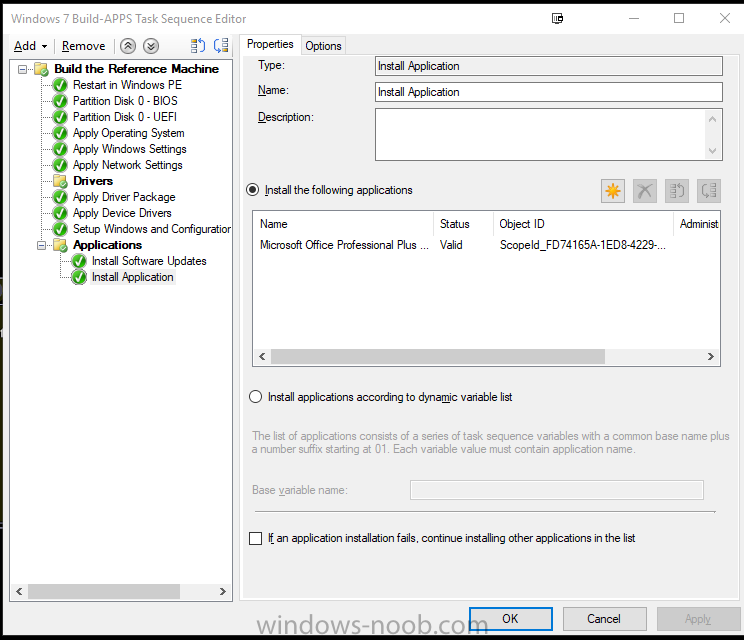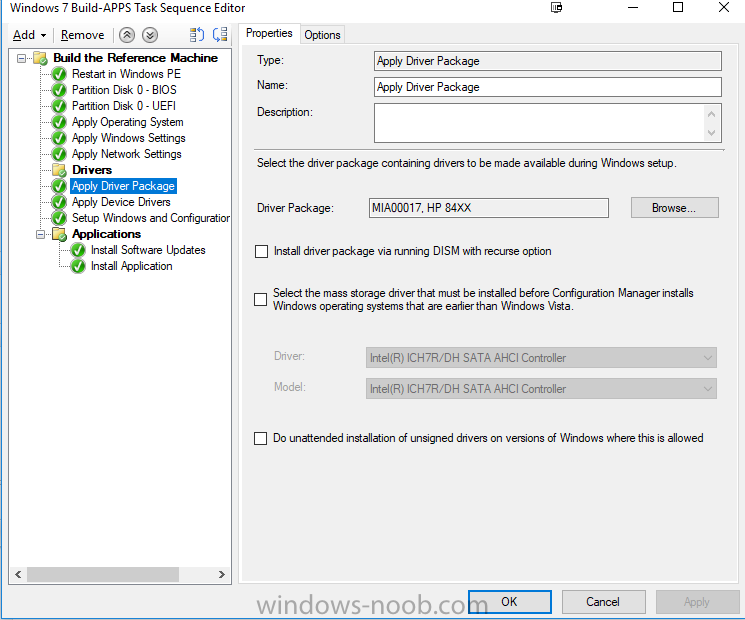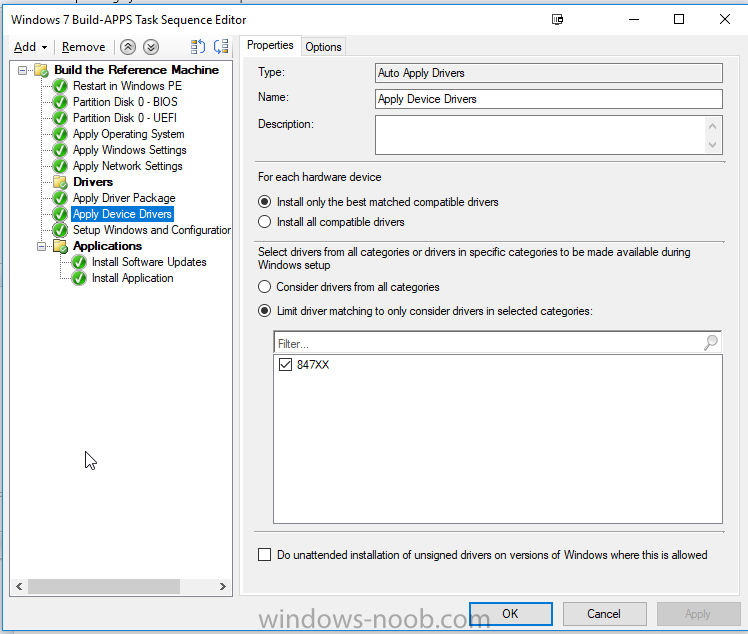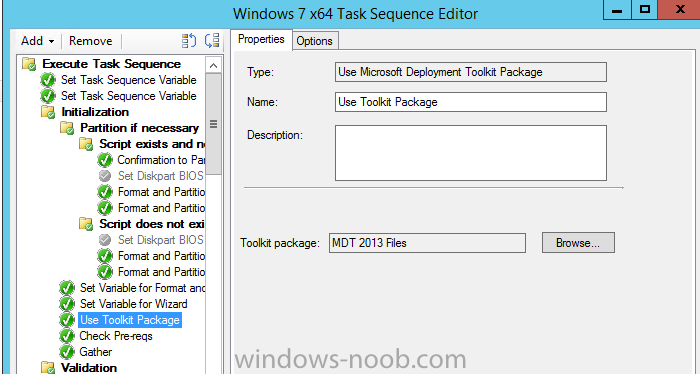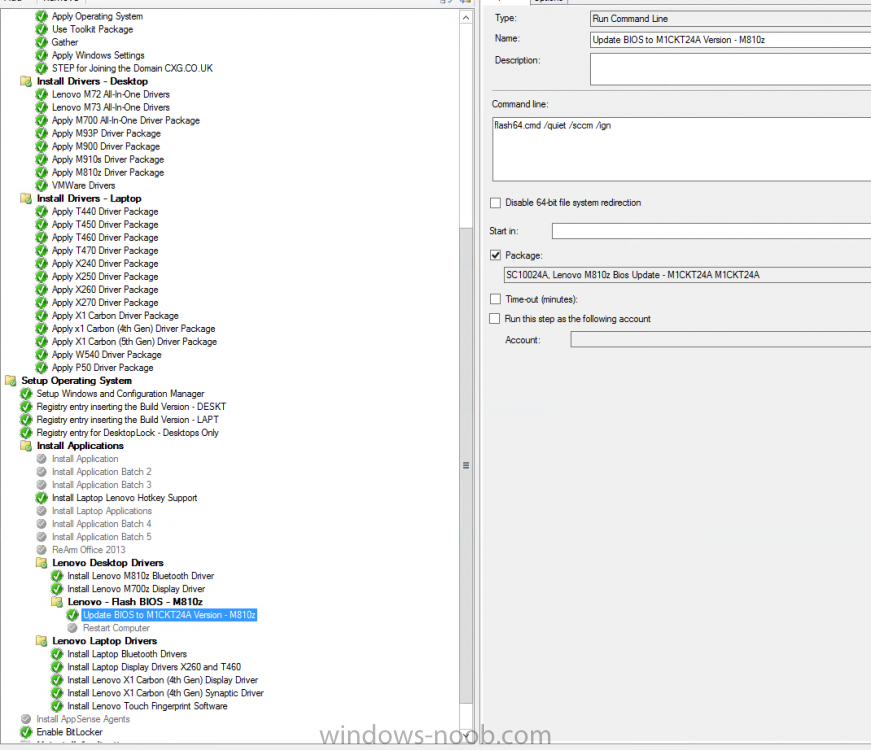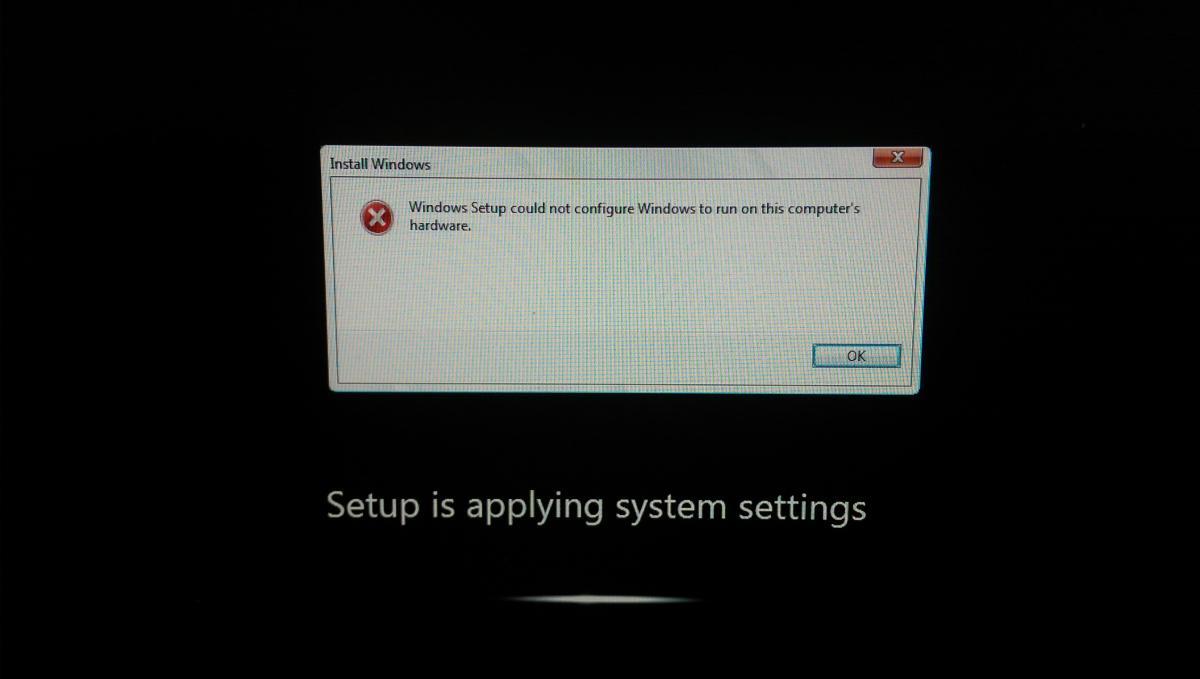Search the Community
Showing results for tags 'osd'.
-
I have an urgent need to image 20 new sites at a new facility we have brought onboard. I set up the new DP and distributed all needed packages. Now when trying to image my task sequence keeps getting stuck at "use Toolkit package step. Ive checked network account settings, and Redeployed "MDT 2013 file" package which is whats under that task but still cant get it to work. Please let me know what else may need to be done on my end.
-
HI Guys, so I have an issue that has had me stumped for some time now and im about ready to throw these tablets out the window. I have HP Elite x2 1012 G1 tablets, I can image them just fine using PXE or USB, and i know it works just fine (Im evening using one right now imaged that same way) I decided to make life difficult by opening one of these up, switching out the M.2 SSD with a larger 525gb Crucial drive. I have had a number of issues on it imaging with the crucial drive, Ive finally gotten to a point where it images and boots into windows 10, if I reboot, it comes right back up. but the minute I shut the computer down and turn it back on, it immediately gives me the error: "Recovery Your PC/Device needs to be repaired a required device isnt connected or cant be accessed Error code: 0xc000000f" now, i checked the BIOS settings and it does in fact see the crucial SSD. has anyone had an issue like this? OSD finishes, boots into windows, shut it down, turn it back on then it no longer sees the drives. something tells me it has to do with the UEFI stuff but Im not entirely sure at this point. hopefully someone has the answer to this, Im pretty sure im doing something wrong or missing something and of course if any more information is needed I can provide that. thanks in advance!
-
Hello, I'm having issues bitlockering M810z with SCCM, it seems to go through fine but it appears that the TPM version is set to 2.0, I saw on the latest BIOS version that there's support for 'TPM FW Switch Feature' so hoping this is what I need, I've set up SCCM to flash the BIOS for this model, but is there any BIOS settings that I can push through SCCM to ensure that the TPM module is set to 1.2? The TPM chip is set to 'Discrete' already... BIOS I'm upgrading to is here: http://pcsupport.lenovo.com/ec/en/products/DESKTOPS-AND-ALL-IN-ONES/THINKCENTRE-M-SERIES-DESKTOPS/M810Z/downloads/DS121000 I'm also having issues updating the BIOS via OSD as I'm unsure where abouts to insert the install\reboot steps as it needs to before the 'Enable Bitlocker' step, here's what my TS looks like at present, deploying Windows 7 Enterprise x64: Any advice?
-
team, I have Offices spread about the world with DPs at each of them. I'm cooking with Config Man CB 1702, Single site. 14 internal DPs and 1 internet facing DP. Shiny. Albeit Drivers, Packages or Applications; not every site (office) requires all content I have to offer. I have a single OSD TS I'd like to use, but I cannot afford distributing every package to every DP around the globe. e.g. a site sporting only laptops does not need to have all desktop drivers on their DP. The problem and question is: How do I keep the TS from failing it's dependency check when a laptop only site UEFI PXE boots to run this single OSD TS and cannot find a package on it's DP; for this example the Desktop driver Packages? In advance, thank you kindly
-
- single task sequence
- osd
- (and 7 more)
-
My environment; Running SCCM 2012 R2 on 2012 R2 server DC Server 2012 R2 All running on VM's on Windows 8 hyper-v When doing any deployment now OSD deployment fails on "preparing network connections" ?I have recently upgraded all my lab to 2012 R2 servers and SCCM 2012 R2 I have built from scratch again.My deployments did work ok when it was all server 2012/sccm 2012 sp1 .I was thinking possibly need some sort of network drivers in the boot image - but my lab is all on a windows 8 hyper-v vm's and did not need to inject driver packages when it was the previous svr 2012/sccm 2012 SP1 enviroment ? Any ideas ?
-
Hello all, I've been using SCCM OSD to image machines for about 2 years. Suddenly last month, it stopped working. I assumed that we had a corrupted driver or boot wim. I re-created both the x64 and x86 boot wims, downloaded the newest WinPE 10 drivers, etc. and am still having the issue. When doing PXE boot, I"m getting the failure at preparing network connections. When loading PE from a usb, it loads but then says "There are no task sequences available for this computer." If I do an F8 , ipconfig shows an IP and diskpart shows the drives, which I assume means that I have the correct drivers. Fwiw- I've tried just about every driver combination that I can think of, to no avail. To make matters worse, our MS premier support contract ended the day before it broke and we're waiting for our legal dept. to sign the new enterprise agreement, so I have no MS support. I'm including the smsts.log from one of the machines and wireshark packet traces from a mirrored port for both PXE and USB PE boots. Any assistance is greatly appreciated, as I need to start pushing Win10 out by the end of the month. SCCMPXE-WINPE-Fail-1.pcapng SCCMUSB-WINPE-Fail-1.pcapng smsts-z230.log
-
I currently have multiple customsettings.ini files that assign computer names based on location + asset tag. I'm wondering if there is a way to have only one file that can do the same when selecting the location from a front end HTA. PS: I can't use the default gateway as the computers are imaged from the same location. Thanks,
- 1 reply
-
- customsettings
- sccm
-
(and 2 more)
Tagged with:
-
This should be easy. I've done it dozens of times, through CM2007 and CM2012R2. Now, with CB, my brain isn't working. Environment variable OSDComputerName created on Unknown Computers collection and no value assigned - Check! TS step Set Task Sequence Variable after Apply Operating System Image with Variable: OSDComputerName and Value:%_SMSTSMachineName% - Check! TS Prompts me for OSDComputerName value prior to starting up and I enter it - Check! OSDBackground pops up and there is my OSDComputerName value on the screen - Check! During deployment, after rebooting, OSDComputerName changes to MININT-XXXXXX, and the value I input when starting the TS is overwritten. This tells me that _SMSTSMachineName is overriding OSDComputerName instead of vice versa. Looking back at the TS in my old 2012R2 environment I have the Set Task Sequence Variable step set the same way. Where have I gone wrong?
-
Currently working on a Windows 10 project , I want to get your input on how you distribute your image to the different departments: same image for all users , based on application security groups, or different task sequences for each department.Please share how you proceed and what do you recommend.
- 1 reply
-
- windows 10
- osd
-
(and 2 more)
Tagged with:
-
We are running into an issue with some brand new laptops that they are stopping in the middle of the task sequence with the error Page_Fault_In_NonPaged_Area. This happens at different times during the TS. Sometimes it is right after the Domain Join step when it is Initializing the SCCM Client. Sometimes it happens during the next step in our process, which is enabling .Net 3.5. I tried moving some of the steps around the TS to isolate the issue, but it doesn't seem to be a certain step causing it. We put one of our old laptops in the same collection and everything works fine. The new laptops have 8GB RAM. 4GB that came with it and 4GB that we added. We have tried with just one of the 4GB (tried with each of them by themselves) modules and the same problem. We have tried with SSD and HDD. Same problem using both types of drives. Any help would be much appreciated. Thanks! I have attached 2 of the smsts logs. smsts1.log is from the _SMSTaskSequence Folder in C:\ smsts2.log is from C:\windows\CCM\logs\ smsts1.log smsts2.log
-
Hi please help I'm pulling my hair out! After imaging a client with Windows 10 using SCCM and MDT integrated task sequence the region and language keeps defaulting to US region and language. I have altered the MDT unattended XML file to add EN-GB as this: SetupUILanguage> <UILanguage>en-US</UILanguage> </SetupUILanguage> <InputLocale>en-GB</InputLocale> <SystemLocale>en-GB</SystemLocale> <UILanguage>en-US</UILanguage> <UserLocale>en-GB</UserLocale> I have also added these to the customsetting.ini file: SkipLocaleSelection=YES KeyboardLocale=0809:00000809 UserLocale=en-GB UILanguage=en-GB SkipTimeZone=YES TimeZoneName=GMT Standard Time The image was captured with the UK region and language setting set for all users in Audit Mode. And still after deployment the language is set to US!!! I also get "something went wrong" before login after OSD. Any help would be much appreciated
-
I've been having some trouble getting newly imaged computers to accept a new name during OSD using the "OSDComputerName" variable. First, some history...I had a fully working SCCM environment that worked perfectly with OSD. Then our cert authority's root cert expired, and everything went to hell. I had to rebuild SCCM and migrated/exported/imported all objects, including images and task sequences. That's where we are today. This is SCCM 1702 with full version 5.00.8498.1711, with MDT integrated (though I have 0 experience doing anything too complex with MDT). OSD is working, and for known devices the computer is keeping the computer name through use of the "_SMSTSMachineName" variable (see attachment sccm1.png) For Unknown computers, during OSD I am successfully prompted for the "OSDComputerName" variable, and I can plug it in just fine. The variable is part of the unknown computers collection (see sccm2.png). When OSD completes, the computer receives a "MININT-_______" name and not the name I've given it. On the old SCCM server, the computers would successfully accept the new name. This is the result in multiple task sequences (we have 3 copies of the task sequence...one for Win10, one for win7, and a win7 one with customization for a specific purpose). Per this article I have recreated the task sequence from scratch, but got the same result: https://social.technet.microsoft.com/Forums/en-US/a8d05720-946c-4960-b978-c517cb56310c/osdcomputername-not-working?forum=configmanagerosd I have NOT captured a new WIM, I may try that shortly, though I doubt it's the issue. The task sequence is deployed as "Available" and not "Required." We have a simple configuration with 1 site and 1 DP. I've attached an smsts.log file for one of these deployments. I don't even see acknowledgement of the computer name I entered when prompted (which begins with SEIU- )I'm totally stumped for next troubleshooting steps and would appreciate any feedback.smsts.log
-
Hello, I was following below article for Windows 10 Upgrade Assessment. I have created Upgrade Assessment task sequence with steps to set custom TS variable on value of _SMSTSOSUpgradeActionReturnCode TS variable. https://deploymentresearch.com/Research/Post/533/Improving-the-ConfigMgr-Inplace-Upgrade-Task-Sequence My TS is setting custom variables (Message) depending upon the value assigned to _SMSTSOSUpgradeActionReturnCode . But what I observed is TS variable evaluation returns true only for _SMSTSOSUpgradeActionReturnCode = 3247440400 else returns false as per smsts.log even condition is matching. For example: 1) _SMSTSOSUpgradeActionReturnCode = 3247440400, set Message = No compatibility issues => Happening 2) _SMSTSOSUpgradeActionReturnCode = 3247440392, set Message = Compatibility issues => Not happening because evaluated to false. I confirmed by dumping TS variables to text file and found it _SMSTSOSUpgradeActionReturnCode = 3247440392 but still condition evaluates to false as per smsts.log. I have changed order of steps of setting TS variable, use of Dynamic Variable but outcome is same. I am using steps from below URL for setting custom message: Any help or thought to solve this puzzle is highly appreciated.
-
- osd
- ts variable
-
(and 1 more)
Tagged with:
-
I'm trying to set up a task sequence to deploy Windows 10 via PXE. We have SCCM 2012 SP2 CU4 running on Server 2012 (not R2), with WDS 6.5.9200.16384, ADK 10.1.14393.0, and MDT 6.3.8443.1000. It's s single site and single server. I'm building the image from the official v1607 Enterprise ISO in a VM, entering System Audit Mode and doing some minimal config, and then using a freshly-built SCCM Capture Media ISO to handle the sysprep and image capture. Once captured, I create a basic (non-MDT) task sequence and deploy it as available to the unknown computers group for media and PXE only. If I have the task sequence join the domain and install the Configuration Manager client, everything works fine. I end up with an inaccessible defaultuser0 account on the machine, but I can log in with a domain account and do what I need to do / give it to a user. However, if I have the task sequence not join the domain, then I can't log into the machine after the image is deployed. It does the specialize pass and then does the "checking for critical updates" step, reboots, and then it gets to a login screen for "defaultuser0" and I can't log in. I've checked on the source VM after another fresh build from the installation ISO, and the defaultuser0 account seems to get created as part of the Windows 10 Enterprise v1607 installation. Even if I delete this account before capturing the image, the defaultuser0 account shows up after deployment. (We do everything in system audit mode and do not create any accounts.) I've tried setting the options within the task sequence to enable the admin account and set the password, but it's still not enabled and I can't do anything. If I try restarting in safe mode or enabling the command prompt, the only account listed/selectable is "defaultuser0" and I can't log into it at all. I've also tried adding net user command line steps to the task sequence to add a new local user and add it to the local administrators group, but this causes the task sequence to fail with 0x00000002. The task sequence that doesn't join the domain also does not install configuration manager - this task sequences is for machines that will be off the domain and off the network and not centrally managed. My guess is these steps can't run in the WinPE environment, but I was unable to find any relevant info in the smsts log. If I could get the task sequence / capture media to trigger the standard OOBE, I think that would work fine for our purposes. But I don't know how I can do that. The capture media doesn't seem to have any options I can control for the sysprep step. Could I just remove the "Apply Windows Settings" step in the task sequence entirely to achieve the same result? Again, we're not using MDT because this is a simple, bare bones image and task sequence. Our goal is to PXE boot and install Windows 10 Enterprise with updates and a few applications pre-installed. For domain-joined machines, they get policy after booting into the OS and get all the other stuff that they get. For machines off the domain, all we need is access to a local admin account so we can log in and do a light touch config, depending on each user. If this isn't possible without MDT, then we'll look at creating the MDT packages and task sequences. Thanks.
- 2 replies
-
- defaultuser0
- pxe
-
(and 3 more)
Tagged with:
-
Hi, I'm struggling to find a definative answer to a question. Is it possible to rebuild a machine via an OSD task sequence within SCCM 2012 R2? Is SCCM working correctly in that if I have previously built a machine via a task sequence, then try to rebuild that machine it does not see that same task sequence and therefore will not be able to be rebuilt? I have a sequence deployed to all unknown computers. The 1st time it builds fine, if I then try to rebuild, it will not see the task sequence. I am assuming as it's no longer an unknown computer. Part of the sequence places the computer in a specified OU, it seems that sometimes it will see the sequence, sometimes it will not. I am using a usb build key with not pxe boot server. Is it expected behaviour that you should delete the computer from SCCM and then rebuild, is there a work around to allow support staff who don't have access to SCCM to rebuild machines? Any help appreciated.
-
I captured an image from a HP t520 Thin Client (Windows 7 Embedded) and all seemed to go well, until I'm now trying to deploy it via Task Sequence from a boot disk. The TC boots into PE and the TS seems to run fine and gets through all of it's steps then reboots. That's when I get this error: (See attached image) Any ideas? I pulled the smsts.log from X:\Windows\Temp right before the reboot and everything seems to look good in there. I'm pulling out what is left of my hair over here!
-
Hi All We have upgraded to SCCM 2012 1702 with hotfix KB4019926 installed, everything seems to have installed fine. I am using the pre-production client which appears to be working a treat and turned my attention to OSD task sequences to test the new client on a build. The task sequence is ignoring the pre-production client despite the option "use pre-production client package when available" being ticked and instead installs the current production client. If i change the task sequence option to use the pre-production client instead of the production client it installs fine so the client does seem to work fine in OSD It just doesn't work if i leave the production client as the live client and tick the option to use pre-production client when available. Couldn't see anything in the logs to explain the behaviour Any help would be appreciated, thanks in advance
-
While I've been working with SCCM for over 6 years I have what's probably a "newbie" question. Is it ok to import drivers while current task sequences are running that deploy operating systems to clients? I won't be editing the task sequences just importing new model drivers (we do use auto apply). When I first started doing os deployments I made the mistake of editing a task sequence that was probably being used and it got corrupted. I don't want that to happen again thus my question now. In the past I've always been careful to import drivers only during change management windows and after I announced to our IT department that imaging was not to take place for a certain amount of time. Is this necessary?
-
- osd
- sccm cb 1606
-
(and 1 more)
Tagged with:
-
I've read some varying info on deploying applications using variables. What I'm trying to do is that lets day I have a machine name "PD-000001" and one named "EH-000001" i'd like to install a certain set of applications based upon the first two or three characters of the computer's name which indicates the department the computer is in. Anyone have any good reading on this or have done it? Thanks!
- 1 reply
-
- osd
- application
-
(and 1 more)
Tagged with:
-
Hello Everyone, I have an interesting problem. I have an OSD to deploy Windows 7 in SCCM 2012 SP1 that works perfectly, expect when imaging one model of laptop. The OSD fails to join the domain, I check the logs in Windows\Panther\UnattendGC on the laptop and they say that the laptop is unable to find the domain. I suspected that this was a driver issue, however when I login to the laptop there is a driver and I am able to manually join the domain without issue. Can any one point me in the right direction? Many Thanks Jim
-
Hello, I'm having a weird issue with the HP 1030 G2 x360 laptop\convertible. When I tried to image it ,my TS failed to detect it as a Laptop, it turned out that it has a new chassis type 31. So I added the chassis type to the ztigather.wsf, however it still didn't detect the chassis type. If objInstance.ChassisTypes(0) = 12 or objInstance.ChassisTypes(0) = 21 then ' Ignore docking stations Else If not IsNull(objInstance.SMBIOSAssetTag) then sAssetTag = Trim(objInstance.SMBIOSAssetTag) End if Select Case objInstance.ChassisTypes(0) Case "8", "10", "11", "12", "14", "18", "21", "31" bIsLaptop = true Case "3", "4", "5", "6", "7", "15", "16" bIsDesktop = true Case "9" bIsTablet = true Case "23" bIsServer = true Case Else ' Do nothing End Select End if
- 1 reply
-
- chassis type
- sccm
-
(and 2 more)
Tagged with:



